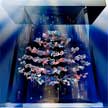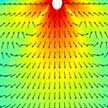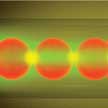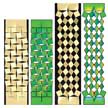Showing Spotlights 601 - 608 of 2879 in category All (newest first):
 The density of proteins in solution is an important fundamental biophysical quantity that has not been accurately measured yet. This has led to extensive debate in the literature regarding the precise density value of proteins. This rough density metric can often lead to inaccurate estimates on the other physicochemical and composite protein features, especially after their interactions with other materials such as nanoparticles. Researchers have now demonstrated a new technique using superparamagnetic iron oxide nanoparticles for magnetic levitation, which promises a more precisely measurement of the density of proteins in solution.
The density of proteins in solution is an important fundamental biophysical quantity that has not been accurately measured yet. This has led to extensive debate in the literature regarding the precise density value of proteins. This rough density metric can often lead to inaccurate estimates on the other physicochemical and composite protein features, especially after their interactions with other materials such as nanoparticles. Researchers have now demonstrated a new technique using superparamagnetic iron oxide nanoparticles for magnetic levitation, which promises a more precisely measurement of the density of proteins in solution.
Jan 13th, 2020
 Researchers have developed numerous applications with structural colors, among them the creation of sophisticated security features for anti-counterfeiting. Covert polarization displays, for instance, provide a barrier to the inadvertent viewing of encrypted optical information without compromising packaging aesthetics. To break through the flexibility/scalability limitation of existing systems, researchers have now developed a large-area covert polarization display technology by using ultrathin lossy nanocolumns deposited on a metal film. This clever strategy for switching covert optical information uses polarization-dependent multicolors without structurally sophisticated fabrication processes.
Researchers have developed numerous applications with structural colors, among them the creation of sophisticated security features for anti-counterfeiting. Covert polarization displays, for instance, provide a barrier to the inadvertent viewing of encrypted optical information without compromising packaging aesthetics. To break through the flexibility/scalability limitation of existing systems, researchers have now developed a large-area covert polarization display technology by using ultrathin lossy nanocolumns deposited on a metal film. This clever strategy for switching covert optical information uses polarization-dependent multicolors without structurally sophisticated fabrication processes.
Jan 10th, 2020
 The combination of multiple therapeutic modalities with synergetic effects is a promising approach to enhance antibacterial efficiency and possibly decrease the needed concentration of bactericidal reagents. In new work, scientists report a path to achieve efficient localized bacterial eradication and anti-infective therapy by combining the advantages of 2D graphene and metal organic framework (MOF)-derived carbon nanomaterials. This proposed MOF-derived 2D carbon nanosheets (2D-CNs) can form aggregations spontaneously under NIR irradiation and meanwhile exhibit localized triple bactericidal modalities.
The combination of multiple therapeutic modalities with synergetic effects is a promising approach to enhance antibacterial efficiency and possibly decrease the needed concentration of bactericidal reagents. In new work, scientists report a path to achieve efficient localized bacterial eradication and anti-infective therapy by combining the advantages of 2D graphene and metal organic framework (MOF)-derived carbon nanomaterials. This proposed MOF-derived 2D carbon nanosheets (2D-CNs) can form aggregations spontaneously under NIR irradiation and meanwhile exhibit localized triple bactericidal modalities.
Jan 2nd, 2020
 Plasmonic 'nanotweezers' are structures made of noble metals that concentrate and absorb light, resulting in 'plasmonic hotspots' that make it possible to manipulate nanoscale objects suspended in a fluid. Trapping or sensing of nanoparticles using nanotweezers suffers from an intrinsic problem of low throughput as the particle delivery process is often diffusion-limited. Researhers have developed bubble- and convection-assisted trapping techniques that overcome the diffusion-limited trapping in nanoaperture tweezers and enable a reduction of 1-2 orders of magnitude in particle-trapping time compared to that of a diffusion-limited trap.
Plasmonic 'nanotweezers' are structures made of noble metals that concentrate and absorb light, resulting in 'plasmonic hotspots' that make it possible to manipulate nanoscale objects suspended in a fluid. Trapping or sensing of nanoparticles using nanotweezers suffers from an intrinsic problem of low throughput as the particle delivery process is often diffusion-limited. Researhers have developed bubble- and convection-assisted trapping techniques that overcome the diffusion-limited trapping in nanoaperture tweezers and enable a reduction of 1-2 orders of magnitude in particle-trapping time compared to that of a diffusion-limited trap.
Dec 23rd, 2019
 Researchers have developed a facile and versatile strategy to directly print hydrogels into biomimetic soft robots. Hydrogel materials possess intrinsic softness and they also exhibit other favorable properties that make them a perfect fabrication material for biomimetic soft robots: stretchability, biocompatibility, permeability, and stimuli-adaptability. The team harnesses biocompatible alginate as a rheological modifier to manufacture 3D freeform architectures of both chemically and physically cross-linked hydrogels using the direct-inkwrite printing.
Researchers have developed a facile and versatile strategy to directly print hydrogels into biomimetic soft robots. Hydrogel materials possess intrinsic softness and they also exhibit other favorable properties that make them a perfect fabrication material for biomimetic soft robots: stretchability, biocompatibility, permeability, and stimuli-adaptability. The team harnesses biocompatible alginate as a rheological modifier to manufacture 3D freeform architectures of both chemically and physically cross-linked hydrogels using the direct-inkwrite printing.
Dec 18th, 2019
 Optical biosensors and micromotors that can sense and actuate biological environments are considered promising theranostic devices because of their high spatial resolution and flexibility.
Advancing the field from synthetic sensors to living materials - which often can be incompatible with biological systems - researchers have assembled living biosensors and micromotors using an in vivo red blood cell (RBC) waveguide for applications in pH sensing and particle transport. This living biosensor can be used for the diagnosis of pH-related disorders of the blood; then, the waveguide can rotate as a micromotor and transport microparticles to the target region.
Optical biosensors and micromotors that can sense and actuate biological environments are considered promising theranostic devices because of their high spatial resolution and flexibility.
Advancing the field from synthetic sensors to living materials - which often can be incompatible with biological systems - researchers have assembled living biosensors and micromotors using an in vivo red blood cell (RBC) waveguide for applications in pH sensing and particle transport. This living biosensor can be used for the diagnosis of pH-related disorders of the blood; then, the waveguide can rotate as a micromotor and transport microparticles to the target region.
Dec 16th, 2019
 Researchers show that by introducing a surfactant layer to modify the particle-substrate interactions, a variety of colloidal particles can be manipulated in a non-invasive and contactless way through coordinating optical heating and scattering forces. This novel technique provides a versatile and powerful platform to manipulate and reconfigurably assemble colloidal particles on solid substrates, without the need to involve fluidic environments. This technique represents a milestone in pushing the working conditions of optical tweezers from fluidic to solid phases, which is capable of versatile manipulation and dynamic assembly of colloidal nanostructures on solid substrates directly.
Researchers show that by introducing a surfactant layer to modify the particle-substrate interactions, a variety of colloidal particles can be manipulated in a non-invasive and contactless way through coordinating optical heating and scattering forces. This novel technique provides a versatile and powerful platform to manipulate and reconfigurably assemble colloidal particles on solid substrates, without the need to involve fluidic environments. This technique represents a milestone in pushing the working conditions of optical tweezers from fluidic to solid phases, which is capable of versatile manipulation and dynamic assembly of colloidal nanostructures on solid substrates directly.
Dec 13th, 2019
 Researchers have identified kirigami as an intriguing tool to create programmable mechanical metamaterials with unconventional mechanical and morphological responses. These reconfigurable metamaterials offer a new material platform to achieve dramatic changes of mechanical and optical properties, which are arising from dynamically tunable geometrical structures. A key feature of kirigami metamaterials is that they are conveniently cut when flat and then exploit local elastic instabilities to transform into complex 3D configurations upon stretching.
Researchers have identified kirigami as an intriguing tool to create programmable mechanical metamaterials with unconventional mechanical and morphological responses. These reconfigurable metamaterials offer a new material platform to achieve dramatic changes of mechanical and optical properties, which are arising from dynamically tunable geometrical structures. A key feature of kirigami metamaterials is that they are conveniently cut when flat and then exploit local elastic instabilities to transform into complex 3D configurations upon stretching.
Dec 12th, 2019
 The density of proteins in solution is an important fundamental biophysical quantity that has not been accurately measured yet. This has led to extensive debate in the literature regarding the precise density value of proteins. This rough density metric can often lead to inaccurate estimates on the other physicochemical and composite protein features, especially after their interactions with other materials such as nanoparticles. Researchers have now demonstrated a new technique using superparamagnetic iron oxide nanoparticles for magnetic levitation, which promises a more precisely measurement of the density of proteins in solution.
The density of proteins in solution is an important fundamental biophysical quantity that has not been accurately measured yet. This has led to extensive debate in the literature regarding the precise density value of proteins. This rough density metric can often lead to inaccurate estimates on the other physicochemical and composite protein features, especially after their interactions with other materials such as nanoparticles. Researchers have now demonstrated a new technique using superparamagnetic iron oxide nanoparticles for magnetic levitation, which promises a more precisely measurement of the density of proteins in solution.
 Subscribe to our Nanotechnology Spotlight feed
Subscribe to our Nanotechnology Spotlight feed





